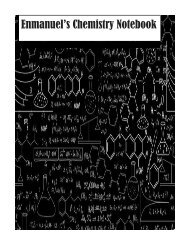Create successful ePaper yourself
Turn your PDF publications into a flip-book with our unique Google optimized e-Paper software.
we can determine that 2 moles of HCl will react with 2 moles of Na(s) to form 2 moles of NaCl(aq) and 1<br />
mole of H2(g). If we know how many moles of Na we start out with, we can use the ratio of 2 moles<br />
of NaCl to 2 moles of Na to determine how many moles of NaCl were produced or we can use the<br />
ration of 1 mole of H2 to 2 moles of Na to convert to NaCl. This is known as the coefficient factor. The<br />
balanced equation makes it possible to convert information about one reactant or product to<br />
quantitative data about another element. Understanding this is essential to solving stoichiometric<br />
problems.<br />
Example 1<br />
Lead (IV) hydroxide and sulfuric acid react as shown below. Balance the reaction.<br />
Solution<br />
___Pb(OH)4 +___H2SO4→___Pb(SO4)2 +___H2O<br />
Start by counting the number of atoms of each element.<br />
Unbalanced<br />
Pb 1 1 Pb<br />
O 8 9 O<br />
H 6 2 H<br />
S 1 2 S<br />
The reaction is not balanced; the reaction has 16 reactant atoms and only 14 product atoms and does<br />
not obey the conservation of mass principle. Stoichiometric coefficients must be added to make the<br />
equation balanced. In this example, there are only one sulfur atom present on the reactant side, so a<br />
coefficient of 2 should be added in front of H2SO4to have an equal number of sulfur on both sides of<br />
the equation. Since there are 12 oxygen on the reactant side and only 9 on the product side, a 4<br />
coefficient should be added in front of H2O where there is a deficiency of oxygen. Count the number<br />
of elements now present on either side of the equation. Since the numbers are the same, the<br />
equation is now balanced.<br />
Pb(OH)4 + 2H2SO4→ Pb(SO4)2 + 4H2O<br />
Balanced<br />
Pb 1 1 Pb<br />
O 8 12 12 9 O<br />
H 6 8 8 2 H<br />
S 1 2 2 2 S<br />
Balancing reactions involves finding least common multiples between numbers of elements present<br />
on both sides of the equation. In general, when applying coefficients, add coefficients to the<br />
molecules or unpaired elements last.<br />
A balanced equation ultimately has to satisfy two conditions.<br />
1. The numbers of each element on the left and right side of the equation must be equal.<br />
2. The charge on both sides of the equation must be equal. It is especially important to pay<br />
attention to charge when balancing redox reactions.




